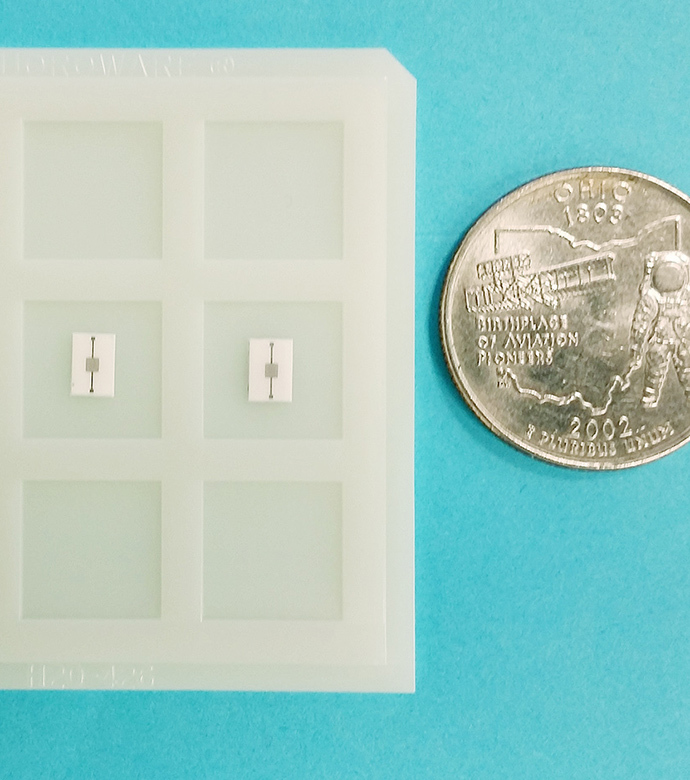Carbon Dioxide Gas Sensors
sensors
Carbon Dioxide Gas Sensors (LEW-TOPS-59)
An enhanced CO2 detecting microsensor with nanocrystalline tin oxide
Overview
Countless industries depend on chemical sensors for fast and accurate detection of carbon dioxide (CO2) to protect their workers and those who rely on their products or services. Consequently, there is a strong push to continuously improve upon these chemical sensors. NASA's Glenn Research Center has developed a state-of-the-art, solid electrolyte-based microsensor for measuring concentrations of CO2 from 0.5 to 4%. Whereas its predecessors typically operated only at high temperatures (600°C), this microsensor operates at temperatures as low as 375°C decreasing the power consumption needed to measure CO2. This is accomplished through a simple modification to a preexisting NASA Glenn technology in which a coating of nanocrystalline tin oxide
(SnO2) is added on top of the sensor. It is low on power consumption, fast, easy to batch fabricate, easy to use, and therefore well-suited for use in a multitude of applications.
The Technology
Current bulk or thick film solid electrolyte CO2 sensors are expensive, difficult to batch fabricate, and large in size. In contrast, this new amperometric, solid-state, oxide-based electrolyte CO2 microsensor is affordable, easy to fabricate, and is so small that it could easily be integrated onto a substrate the size of a postage stamp.
The basic composition of the sensor is identical to a previously designed NASA Glenn technology in which a solid electrolyte of Na3Zr2Si2PO12 is deposited between interdigitated electrodes on an alumina substrate and is covered by Na2CO3/BaCO3. Unlike its predecessor, however, this innovation includes an additional layer of nanocrystalline SnO2 sol gel, an electron donor type (N-type) semiconductor, on top of the Na2CO3/BaCO3 . This new layer provides a greater number of electrons for reduction reaction at the working electrode to detect CO2. As a result, overall performance is enhanced, and this new state-of-the-art sensor has the ability to operate at temperatures as low as 375°C. This low temperature capability significantly decreases the amount of power required to operate the sensor, opening the door to a multitude of new applications that were previously unattainable.


Benefits
- Power saving: Lower operating temperatures translate to lower power usage
- Compact: Has a detection area of .99 by 1.10 millimeters
- Robust: Resistant to humidity and vibration which can often damage or destroy microsensors
- Cost-effective: Can be easily batch fabricated using affordable photolithographic production processes
- Fast: Detects CO2 concentrations from 0.5 to 4% in less than 30 seconds
Applications
- Environmental monitoring (fire detection, emissions, leak detection, ventilation)
- Health monitoring
- Automotive
- Remote sensing
- Commercial space
- Chemical manufacturing
|
Tags:
|
|
|
Related Links:
|
Similar Results

Solid State Carbon Dioxide (CO2) Sensor
The technology is a solid state, Carbon Dioxide (CO2) sensor configured for sensitive detection of CO2 having a concentration within the range of about 100 Parts per Million (ppm) and 10,000 ppm in both dry conditions and high humidity conditions (e.g., > 80% relative humidity). The solid state CO2 sensor achieves detection of high concentrations of CO2 without saturation and in both dynamic flow mode and static diffusion mode conditions. The composite sensing material comprises Oxidized Multi-Walled Carbon Nanotubes (O-MWCNT) and a metal oxide, for example O-MWCNT and iron oxide (Fe2O3) nanoparticles. The composite sensing material has an inherent resistance and corresponding conductivity that is chemically modulated as the level of CO2 increases. The CO2 gas molecules absorbed into the carbon nanotube composites cause charge-transfer and changes in the conductive pathway such that the conductivity of the composite sensing material is changed. This change in conductivity provides a sensor response for the CO2 detection. The solid state CO2 sensor is well suited for automated manufacturing using robotics and software controlled operations. The solid state CO2 sensor does not utilize consumable components or materials and does not require calibration as often as conventional CO2 sensors. Since the technology can be easily integrated into existing programmable electronic systems or hardware systems, the calibration of the CO2 sensor can be automated.

Polymer Electrolyte-Based Ambient Temperature Oxygen Microsensor
Conventional ambient-temperature oxygen sensors are limited in various ways: optically based sensors can be expensive and challenging to manufacture; electrochemical cells with liquid electrolytes can have limited lifetimes and become leak sources; and both types of sensors are difficult to miniaturize. These problems are addressed with Glenn's novel ambient temperature oxygen microsensor, which is based on a Nafiontm polymer electrolyte, microfabricated using thin-film technologies. In the past, one drawback of Nafiontm film has been that it can lose conductivity when the moisture content in the film is too low, potentially affecting sensor operation. Glenn researchers devised a method to use certain salts to hold water molecules in the Nafiontm film structure at room temperature. The presence of these salts provides extra sites in the film to promote proton (H+) mobility, thus improving film conductivity and overall sensor performance, particularly in arid and high-temperature environments.
The innovative use of metal/metal oxide as the reference electrode enables miniaturization by eliminating the reference gas and sealing the reference electrode. The combination of interdigitized electrodes with the unique metal/metal oxide reference electrode permits sensor operation in either potentiometric or amperometric mode, as appropriate. In potentiometric mode, which measures voltage differences between working and reference electrodes in different gases, the voltage differences can be monitored with a voltmeter; however, the sensor itself does not need a power source. In room-temperature testing, the sensor achieved repeatable responses to 21 percent oxygen in nitrogen (using nitrogen as a baseline gas), and also detected oxygen from 7 to 21 percent, making Glenn's breakthrough technology usable for personal health monitoring as well as fire detection, fuel-leak detection, and environmental monitoring.

Room temperature oxygen sensors
NASA Ames has developed very small-sized oxygen sensors made of a graphene and titanium dioxide (TiO2) hybrid material. With ultraviolet (UV) illumination, these sensors are capable of detecting oxygen (O2) gas at room temperature and at ambient pressure. The sensors are able to detect oxygen at concentrations ranging from about 0.2% to about 10% by volume under 365nm UV light, and at concentrations ranging from 0.4% to 20% by volume under short wave 254nm UV light. These sensors have fast response and recovery times and can also be used to detect ozone.
This unique room temperature O2 sensor provides significant advantages in O2 sensing applications, especially those applications where high operating temperature requirements cannot be met, or would result in inefficient manufacturing processes. Since graphene is not intrinsically responsive to O2, and TiO2 is not responsive to oxygen at room temperature, the materials are first synthesized as a hybrid material. The synthesized graphene- TiO2 hybrid material is then ultrasonicated and then drop-casted onto a series of Interdigitated Electrodes (IDE) to form the sensors.
Ultrasonication ensures effective charge transfer at the graphene- TiO2 interphase. The graphene and the titanium dioxide may be present in the composite material in different ratios to ensure optimal oxygen detection. It is the combination of graphene with TiO2 that yields a semiconducting material capable of O2 sensing at room-temperature operation.

Inexpensive Microsensor Fabrication Process
Because chemical sensors are used in many aspects of space missions, NASA researchers are continually developing ever smaller and more robust sensors that can be manufactured inexpensively and in high quantities; e.g., in batches. Glenn has developed a way to inexpensively fabricate microsensors using a sacrificial template approach. A nanostructure, such as a carbon nanotube, serves as a template, which can then be coated with a high-temperature oxide material. The carbon nanotube can be burned off, or sacrificed, leaving only the metal oxide. The resulting structure provides the unique morphology and properties of the carbon nanotube, which are advantageous for sensing, along with the material durability and high-temperature sensing capabilities of the metal oxide. This technique increases the surface area available for sensing because both the interior and exterior of the resulting microsensor can be used for gas detection, significantly increasing performance.
The fabrication of these microsensors includes three major steps: (1) synthesis of the porous metal or metal oxide nanostructures using a sacrificial template, (2) deposition of the electrodes onto alumina substrates, and (3) alignment of the nanostructures between the electrodes. The invention has been demonstrated for methane detection at room temperature (using tin oxide, with carbon nanotubes as the sacrificial template). The microsensor offers low power consumption (no heating required), compact size, extremely low cost, and simple batch-fabrication.

Advanced Hydrogen and Hydrocarbon Gas Sensors
In conjunction with academia and industry, NASA's Glenn Research Center has developed a range of microelectromechanical systems (MEMS)-based and Silicon Carbide (SiC)-based microsensor technologies that are well-suited for many applications. The suite of technologies includes hydrogen and hydrocarbon leak detection sensors; emissions sensor arrays; and high-temperature contact pads for wire bond connections.
Currently used to protect astronauts on the International Space Station, the hydrogen and leak detection sensors have many Earth-based applications as well. They can function as a single-sensor unit or as part of a complete smart sensor system that includes multiple sensors, signal conditioning, power, and telemetry. The system can comprise sensors for hydrogen, hydrocarbons, oxygen, temperature, and pressure. The emissions sensor array features a gas-sensing structure that detects various combustion emission species (carbon monoxide, carbon dioxide, oxygen, hydrocarbons, and nitrogen oxides) over a wide range of concentrations. In addition, the emissions sensor array remains highly sensitive and stable while providing gas detection at temperatures ranging from 450 to 600°C. These new sensors provide a combination of responsiveness and durability that offers great value for a wide range of applications and industries.



